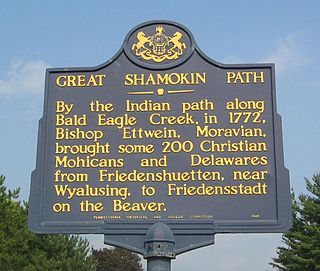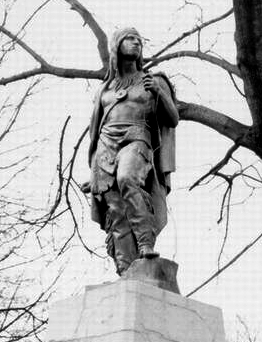Hell Town
Hell Town, Ohio, is a village located on Clear Creek, known today as Clear Fork, near the abandoned town of Newville, Ohio. [1] The site is on a high hill just north of the junction of Clear Creek and the Black Fork of the Mohican River. [1] The reference to the village sitting on a "high hill" counters many popular misconceptions that the village was in low-lying areas that would later be submerged by the damming of the ClearFork River to create Pleasant Hill Lake. Hell Town was located along a "war trail" used by Native Americans in the region, which ran from a point about 30 miles (48 km) south from Sandusky, Ohio, thence north-northeast into the Cuyahoga River valley. This trail was later used by white settlers and is today known as State Route 95. Rerouted in the 1940s, a portion of this old road and war path are buried under Pleasant Hill Lake. [2]
Helltown (actually meaning "town of the clear water") was situated a mile below Newville, on the Clear Fork of the Mohican, in what is known as the Darling settlement. After the murder of the Moravian Indians at Gnadenhutten in 1782, Helltown was abandoned and a new settlement (Greentown) was established on the Black Fork, where a better location for defence was secured.
From History of Richland County. By A J. Baughman. CHAPTER XVI. Monroe Township: William Norris, who lives on a 500-acre farm in "Possum Valley" also owns a fine tract of land which was a part of the original Darling tract, at the site of the former Indian village of Helltown, where the first bridge below Newville crosses the Clearfork. [3] [However, Baughman's assertions about that location, may have been based upon mere supposition, rather than indisputable fact; the prior historians seem to have been uncertain about its precise location.]
Mohican John's Town
Mohican John's town (or "Johnstown") was said, by 19th-century historians, to have been the same as the native-village of "Jerometown", located just south of Jeromesville, Ohio. However, surveys done in the 1760s (etc.), located "Mohican John's town" in the vicinity of present-day Mifflin, Ohio. It is uncertain if the earlier (1760s) "Mohican John's town" Indian village had perhaps been later moved to the alternate location before the 1800s; or if instead, local-historians merely misinterpreted the earlier "John's town" (on the Black Fork of the Mohican) to be the same location as "Jerometown" (on the Jerome Fork of the Mohican). Regardless, the "Mohican John's town" of the 1760s (which was apparently mainly inhabited by members of the "Mingo" tribe), was undoubtedly upon the Black Fork [4] of the Mohican River (and probably near present-day Mifflin, Ohio).
Knapp's History of Ashland County (OH) accurately refers to the native-village near present-day Jeromesville as being named "Jerometown" by 1808. But Knapp's History errs in attributing the original village of "Mohican John's Town" (which was recorded in 1764 to be on the immediate 'east' side of the Black Fork) to be the same native village as Jerometown (which was consistently recorded to be on the near 'western' side of the Jerome Fork). The later historians [5] never noticed Knapp's obvious contradiction, and they simply repeated (and expanded upon) his error.
[Note: some of the early 'histories' implied that "Mohican John" (who was presumably of Native-American heritage) was the same person as John Jerome (a Caucasian of French heritage); but John (or "Jean") Jerome was not yet even born when "Mohican John's Town" was initially recorded to exist. That confusion about the two different men, may have resulted in the error about the actual location of "Mohican John's Town" (or "Johnstown") being the same place as the Native-American-inhabited village of "Jerometown" (near present-day Jeromesville.]

The Allegheny River is a 325-mile-long (523 km) headwater stream of the Ohio River in western Pennsylvania and New York. The Allegheny River runs from its headwaters just below the middle of Pennsylvania's northern border northwesterly into New York then in a zigzag southwesterly across the border and through Western Pennsylvania to join the Monongahela River at the Forks of the Ohio at Point State Park in Downtown Pittsburgh, Pennsylvania. The Allegheny River is, by volume, the main headstream of both the Ohio and Mississippi Rivers. Historically, the Allegheny was considered to be the upper Ohio River by both Native Americans and European settlers.

Armstrong County is a county in the Commonwealth of Pennsylvania. As of the 2020 census, the population was 65,558. The county seat is Kittanning. The county was organized on March 12, 1800, from parts of Allegheny, Westmoreland and Lycoming Counties. It was named in honor of John Armstrong, who represented Pennsylvania in the Continental Congress and served as a major general during the Revolutionary War.

Jeromesville is a village in Ashland County, Ohio, United States. The population was 531 at the 2020 census.

The Kittanning Path was a major east-west Native American trail that crossed the Allegheny Mountains barrier ridge connecting the Susquehanna River valleys in the center of Pennsylvania to the highlands of the Appalachian Plateau and thence to the western lands beyond drained by the Ohio River. Kittanning Village was the first major Delaware (Lenape) Indian settlement along the descent from the Allegheny Plateau.

Kittanning was an 18th-century Native American village in the Ohio Country, located on the Allegheny River at present-day Kittanning, Pennsylvania. The village was at the western terminus of the Kittanning Path, an Indian trail that provided a route across the Alleghenies between the Ohio and Susquehanna river basins.
Gelelemend (1737–1811) (Lenape), also known as Killbuck or John Killbuck Jr., was an important Delaware (Lenape) chief during the American Revolutionary War. He supported the rebel Americans, known as Patriots. His name signifies "a leader." He was born into the Turtle clan, which had hereditary responsibility for leadership, he became principal chief of the Lenape in November 1778, following the death of White Eyes, a war chief and Speaker of the Delaware Head Council. Gelelemend succeeded his maternal grandfather Netawatwees.

The Kittanning Expedition, also known as the Armstrong Expedition or the Battle of Kittanning, was a raid during the French and Indian War that led to the destruction of the American Indian village of Kittanning, which had served as a staging point for attacks by Lenape warriors against colonists in the British Province of Pennsylvania. Commanded by Lieutenant Colonel John Armstrong Sr., this raid deep into hostile territory was the only major expedition carried out by Pennsylvanian provincial troops during a brutal backcountry war. Early on September 8, 1756, they launched a surprise attack on the Indian village.
Shingas was a Lenape chief and warrior who participated in military activities in Ohio Country during the French and Indian War. Allied with the French, Shingas led numerous raids on Anglo-American settlements during the war, for which he was nicknamed "Shingas the Terrible" by the settlers. The colonial governments of Pennsylvania and Virginia responded to these raids by placing a bounty on Shingas.

Shamokin was a multi-ethnic Native American trading village on the Susquehanna River, located partially within the limits of the modern cities of Sunbury and Shamokin Dam, Pennsylvania. It should not be confused with present-day Shamokin, Pennsylvania, located to the east. The village was the focus of missionary efforts, and then was the staging area for raids on English settlements in Pennsylvania during the French and Indian War. It was burned and abandoned by the Lenape in May, 1756. A few months later, Fort Augusta was constructed on the site of the village.

Newville is a now defunct town located near what is now Pleasant Hill Lake, in northeastern Worthington Township, Richland County, Ohio, United States.

Fort Machault was a fort built by the French in 1754 near the confluence of French Creek with the Allegheny River, in northwest Pennsylvania. The fort helped the French control these waterways, part of what was known as the Venango Path from Lake Erie to the Ohio River.

Anderson Creek is a 23.6-mile-long (38.0 km) tributary of the West Branch Susquehanna River in Clearfield County, Pennsylvania, in the United States.

The Great Shamokin Path was a major Native American trail in the U.S. State of Pennsylvania that ran from the native village of Shamokin along the left bank of the West Branch Susquehanna River north and then west to the Great Island. There it left the river and continued further west to Chinklacamoose and finally Kittanning on the Allegheny River.

Captain Pipe (Lenape), called Konieschquanoheel and also known as Hopocan in Lenape, was an 18th-century Head Peace chief of the Algonquian-speaking Lenape (Delaware) and War Chief 1778+. He succeeded his maternal uncle Custaloga as chief by 1773. Likely born in present-day Pennsylvania, he later migrated with his people into eastern Ohio.
Hell Town is the name for a Lenape Native-American village located on Clear Creek near the abandoned town of Newville, in the U.S. state of Ohio. The site is on a high hill just north of the junction of Clear Creek and the Black Fork of the Mohican River.

Kuskusky, also known as the Kuskuskies Towns, Kuskuskie Towns, or Kuskuskies' Indian Town, with a wide variety of other spellings, were several Native American communities inhabited near New Castle, Mahoning, and Edinburg, Pennsylvania, and Youngstown, Ohio, during the mid-18th century. It was not one town, but three or four contiguous towns of the Mingoes, Lenape, and Seneca, located along the Beaver River, at and above the junction of its east and west branches, the Mahoning River and the Shenango River. It is usually referred to in the plural.

Muskingum was a Wyandot village in southeastern Ohio from 1747 to 1755. It was an important trade center in the early 1750s, until it was devastated by smallpox in the winter of 1752. The town was repopulated for a short time afterwards, then abandoned again as a new community was established by Netawatwees a few miles to the east at Gekelukpechink. The city of Coshocton, Ohio was founded close to the site of the village in 1802.

Saucunk or Sawcunk was a town established by the Lenape and Shawnees. It was the site of a Catholic mission and was visited by Conrad Weiser, Christian Frederick Post and George Croghan. Saucunk was abandoned after the Battle of Bushy Run in 1763.

Tamaqua or Tamaque, also known as The Beaver and King Beaver, was a leading man of the Unalachtigo (Turkey) phratry of the Lenape people. Although the Iroquois in 1752 had appointed Shingas chief of the Lenape at the Treaty of Logstown, after the French and Indian War Tamaqua rose in prominence through his active role as peace negotiator, and was acknowledged by many Lenape as their "king" or chief spokesman. He was among the first to hand over English captives at the end of the French and Indian War and was active in peace negotiations at the conclusion of Pontiac's War. By 1758, he was recognized as one of three principal leaders of the Lenape, being the primary spokesman for the western Lenape in the Ohio Country. He founded the town of Tuscarawas, Ohio, in 1756 and died there in 1769 or 1771.

Shannopin's Town, or Shannopintown, was an 18th-century Lenape (Delaware) town located within the site of modern-day Pittsburgh, Pennsylvania, along the Allegheny River, approximately two miles east from its junction with the Monongahela River. In the early 1700s, British colonial settlers began spreading into western Pennsylvania, forcing Lenape and other American Indian tribes to move further west, settling in the Ohio Country. Shannopin's Town was one of several communities established in western Pennsylvania in the 1720s. The town was largely abandoned during the construction of Fort Duquesne in 1754, although a small community still existed when General John Forbes' troops arrived in September 1758. The community was gone by the time construction on Fort Pitt was started in 1759.
















